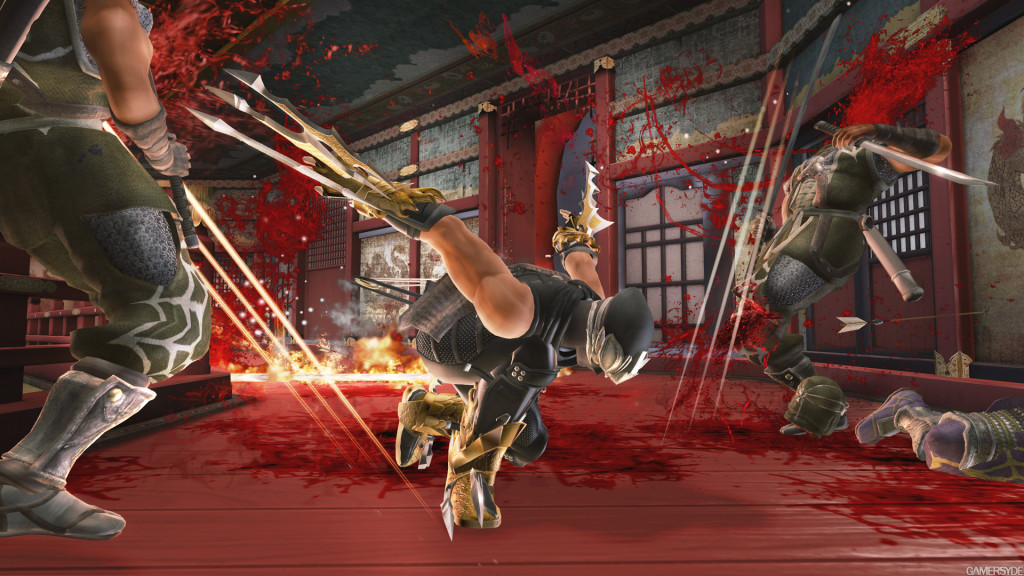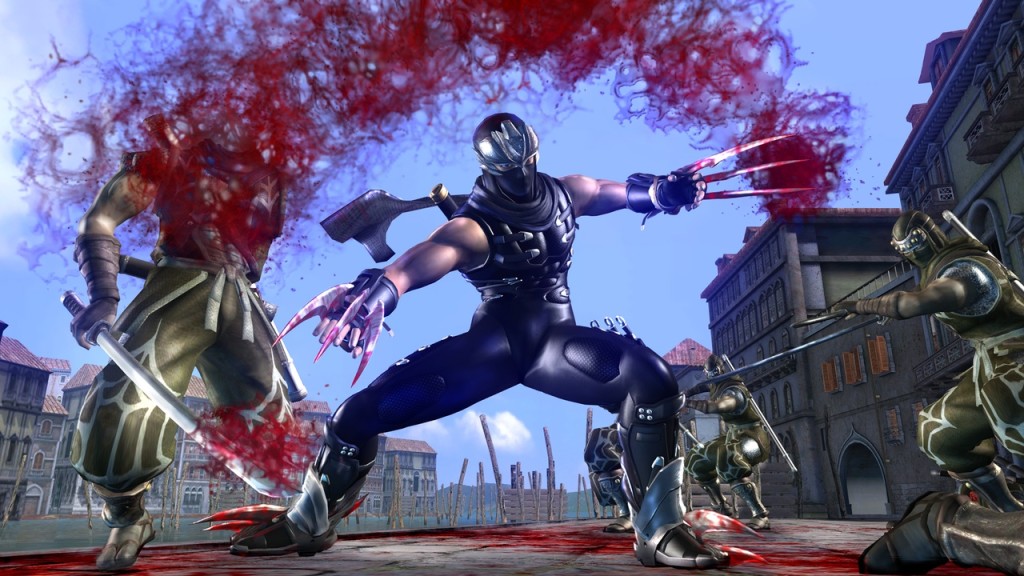Last updated on January 26, 2015
Warning: Explicitly Violent Images Ahead. You Have Been Warned.
That, of course, is exactly what Ninja Gaiden II does. Ninja Gaiden adds to most of those elements, if not more, with The Power of Next-Gen Consoles! If Ninja Gaiden required precision, then Ninja Gaiden II emphasizes something totally different: survival. I think this game throws the most enemies at you of any game that I have ever played, and not in that Dynasty Warriors way. Frequently, you’ll find yourself swarmed with melee ninjas, giant unstunnable creature, projectiles and rockets from afar, and just about any obstacles you can imagine. Each stage progresses in a fairly linear line (with slight deviations for items and optional challenges) from combat sequence to combat sequence; when you reach a save point, you’re just glad you made it. Because of the intensity and density of enemy numbers (not to mention the damage of their attacks), Ninja Gaiden II introduces regenerating health and save points which restore you to full health, meaning they exist more as checkpoints than anything else. Now imagine doing this without any breaks, at all, except for minor diversions; add in tons of boss fights and that’s the Ninja Gaiden II experience altogether.
I can’t begin to tell you how much the general feel of combat’s been improved. It appears they tweaked just about every aspect of the game in some way, both to enhance the play experience and increase the difficulty. Blocking no longer protects you against everything; stronger enemy attacks and explosive rounds can, and will, break your guard, so movement becomes an essential tactic. You can dash away from any blocked attack, which replaces the roll from the first game, and counters allow you to strike back at tougher enemies. Ninja Gaiden II introduces Obliteration Techniques, which allow you to behead/kill enemies which are missing limbs. De-limbing becomes an important part of combat, precisely because it allows you to eliminate enemies quickly while also making you immune to attack. Ultimate Techniques work in much the same way, elaborately destroying enemies while protecting you from damage. Ninpo, as well, gives you some breathing room from the endless onslaught while, hopefully, eliminating a few; Ninpo essence drops with much more frequency this time around, so you’ll be using it a lot.

Boss fights, on the other hand, test pattern recognition and avoidance more than i-frames. Thankfully, all of them present new and different challenge, although they provide little room for error; the lack of a solid block and no i-frames (invincibility) on the dash-roll make it a big process of trial and error to figure out an optimal approach to most fights. Their grab attacks also lack clear tells, so you really won’t see them coming at all unless you’ve seen them before; the game gives all such grabs elaborate, ten second long animations as if to make it clear that you screwed up bad. There are many ways that Ninja Gaiden tells you that it doesn’t like you, your clothes, or your silly hair, and this is just the tip of the iceberg.
If you hadn’t noticed a theme here yet, Ninja Gaiden II’s combat is less about avoiding damage through your superior skill and more about abusing invincibility frames of several moves in sequence to defeat large enemy numbers. The projectile spam from afar makes this necessary, while the essence drops provide you with more than enough firepower to kill whatever’s in front of you. Since you can’t get knocked out of Ultimate Techniques anymore except by very high damage, that’s a huge risk/reward system of using essence, figuring out how to de-limb enemies (which makes them drop essence), and figuring out proper Ninpo usage (dead enemies drop essence!). It all revolves around these techniques! Since Ninpo drops frequently (unlike the first game) and enemies die quickly, you can really turn invincible for long periods of time. I’m curious whether the focus on i-frames were actual design decisions by Tomonobu Itagaki; it’s clear that there’s too much stuff to dodge and block, so it must be the case. Still, this is a huge contrast from the first Ninja Gaiden.
The tactics remain the same throughout, but your choice of weapon, on the other hand, changes according to the situation. Some weapons are faster, some slower, and some contain longer/shorter/wider range Ultimate Techniques. Compared to the first game, the weapon variety’s off the charts, and each weapon finds its use somewhere; it doesn’t hurt that there’s so much combo variation. Personal preference can also play a part, as the innately satisfying attacks of each weapon may endear themselves to you. Higher level play does require specific weapon usage, although I frankly didn’t see a forced need for certain weapons very often. I just like the Scythe, and while it overpowers smaller enemies, it doesn’t quite work on larger groups, so it does balance it out (well, that depends…). Flying Swallow isn’t half as good as it was before, while the Izuna Drop only works in a non-projectile situation, which also means they’ve taken their power (if not their damage) down a notch.

Ranged weapons also play a much larger role; it’s clearly expected that you snipe enemies from afar with the bow and arrow in some sequences, which definitely break up the visceral melee. It’s strange to stand still and aim in any Ninja Gaiden game, but there’s a clear expectation that you must use it; thankfully, the auto-targeting tends to do the job well enough most of the time. Incendiary shurikens take out most normal enemies with little fuss (as well as full-charged Windmill Shuriken), and they also end up as helpful additions to the ranged attacks.
All and all, the combat itself remains incredibly satisfying to conquer. Each group of enemies, in my mind, took a lot of work to figure out the right balance between skill and outright unfairness. Ninja Gaiden II ups the stakes continually, while also providing subtle cues as to the right strategy through item placement, new enemy patterns/reactions, and just solid combat throughout. In fact, I’d call it the most old-school video game released in a long time, considering in the constant gruesome bloodshed, the reliance on RADICAL ’90s tropes of “coolness”, and a overall jumble vibe of a video game being a video game. Tomonobu Itagaki just throws whatever at you, both in game and aesthetically; there’s less plot and more the feeling of doing something important, which Ninja Gaiden II absolutely nails.
